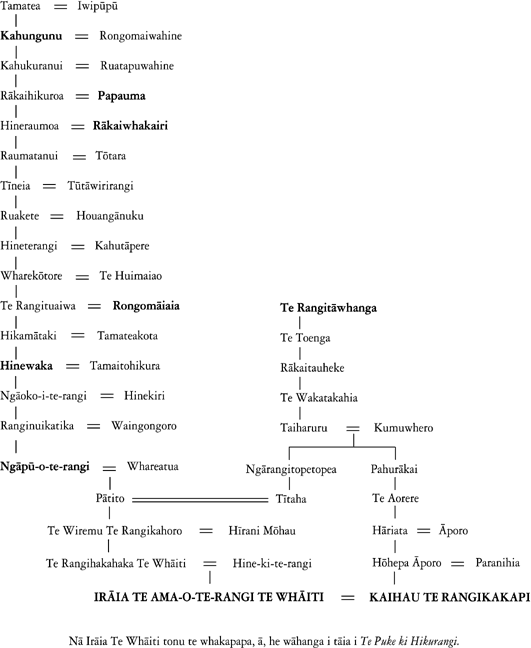Iraia Te Whaiti, also known as Iraia Te Ama and Te Ama-o-te-rangi, was born in south Wairarapa, probably in 1861 or 1862. He was the eldest child of Te Rangihakahaka Te Whaiti and Hine-ki-te-rangi, both of Ngati Kahungunu of Wairarapa. His mother was the sister of Hoani Paraone Tunuiarangi, a noted Ngati Kahungunu leader and tribal historian. Iraia had two full brothers, Hoani Te Whaiti (Tutu Hone Paraone) and Patito, and one half-brother, Meiha Keepa Hiu (Hui) Te Miha.
Iraia Te Whaiti received an extensive education in the traditions and genealogies of the many hapu of Ngati Kahungunu of Wairarapa. In later life he was regarded as a leading expert, and wrote a number of articles in Te Puke ki Hikurangi and other publications. He himself strongly identified with Ngati Ngapu-o-te-rangi, centred in the Whakatomotomo valley, Palliser Bay; he also had strong links with Ngati Hinewaka. It is likely that Hoani Tunuiarangi was responsible for Te Whaiti’s education in tribal history, and he became the guardian of his interests following the deaths of Te Rangihakahaka in 1870 and Hine-ki-te-rangi in 1875.
Te Whaiti inherited land interests in a number of south Wairarapa blocks through both his parents, most notably around the southern coast and in the Whakatomotomo valley. Although remaining a staunch Anglican, he was supportive from the turn of the century of Te Hahi o te Ruri Tuawhitu o Ihowa (also called the Church of the Seven Rules of Jehovah), founded by Haimona Patete. Te Whaiti considered he was following the direction of the prophet Paora Te Potangaroa, when, as a service to his people, he began farming his ancestral land in 1881.
That year, on 1 November according to a family Bible, Te Whaiti married Kaihau Te Rangikakapi Maikara Aporo, of Ngati Hinewaka and Ngati Kauhi hapu of Ngati Kahungunu, and of Ngai Tahu and Ngati Maniapoto. Te Whaiti and Kaihau had 13 children; seven of these died at a young age, largely as the result of various epidemics.
In 1894 Te Whaiti extended the range of his farming activities. He entered into a partnership with a Pakeha farmer, John Sinclair, and bought the huge Whatarangi station from Charles Pharazyn for approximately £10,000. Some of the station was still in Maori ownership at this time, and had been leased by Pharazyn. Sinclair and Te Whaiti bought the rights to the leases. The partnership subsequently became known as Te Whaiti and Sutherland when Mary Sutherland took over from her brother. In 1907 Kaiwaru was added to the holding. Later, Te Whaiti purchased Te Karanga, a block of 770 acres, in his own right. In 1912 he estimated the size of his holdings at 18,000 acres; at this time Whatarangi station carried some 20,000 sheep and nearly 500 cattle. Te Whaiti employed a number of the local hapu in shearing and other activities on the station.
Te Whaiti was one of the few Maori engaged in buying land, and his purchase and operation of the station broke a 40-year pattern of Maori land alienation in the Wairarapa Valley. In 1908 only 140,000 acres of land remained in Maori ownership; of this, only 33,000 acres were being farmed by the owners. Te Whaiti owned at least as much livestock as all other Wairarapa Maori farmers combined. He experimented with various methods of farming and employed Pakeha as well as Maori workers.
Te Whaiti’s expertise in land management was utilised by the wider Wairarapa Maori community. He was elected to the management committee of the reserves for the Wairarapa lakes, and to the management committee of Pouakani, a block of over 30,000 acres situated at present-day Mangakino; it was given to Wairarapa hapu by the government in exchange for the Wairarapa lakes. Te Whaiti also wrote a number of items about farming and agricultural techniques in Te Puke ki Hikurangi.
He was also elected to a number of other committees to represent the interests of his family and hapu. He was the chairperson of the committee of the Kohunui marae, and was a member of the management committee at Papawai pa, the site of the Maori parliament. In 1906 he was elected to the Rongokako Maori Council, the principal governing body of Wairarapa Maori society in the 20 years following 1900. Later he became deputy chairman. He remained a member of the council until at least 1912. In addition, Te Whaiti was a lieutenant in the Wairarapa Mounted Rifle Volunteers, a Maori military company, and was a director of the Mareikura Company, which published a newspaper.
In later life Te Whaiti moved with his family to Te Karearea, a large house in Greytown. He and Kaihau became popular figures in Greytown public life, and took part in a number of community activities. The couple made donations to various public works, and were prominent in the patriotic fund-raising society during the First World War. About 1908 Iraia became a Freemason – the first Maori to do so.
Te Whaiti died from influenza in Greytown on 15 November 1918. He was buried at Ranana cemetery, in the Whakatomotomo valley; a stone memorial was erected by his family in 1923. At the time of his death his considerable personal wealth was estimated at £36,000. The Te Whaiti and Sutherland partnership was dissolved at his death, and his holdings were divided between his three surviving sons; there were also three surviving daughters. Kaihau lived for another 18 years at Te Karearea in Greytown, before she died on 19 January 1937. She was buried next to her husband at Ranana.

